- Blog
- Skims Marketing Breakdown: A Masterclass in Modern Branding
Skims Marketing Breakdown: A Masterclass in Modern Branding
-
Nikolett Lorincz
- Marketing Breakdowns
- 6 min read
Table of Contents
When it comes to modern-day brand success, few stories are as impressive as the story of Skims.
Launched by Kim Kardashian in 2019, Skims took the shapewear and loungewear industry by storm, amassing a staggering valuation of $4 billion in just a few years.
How did a relatively new brand rise so quickly in such a competitive market? The secret lies in its well-crafted marketing strategy, which combines inclusivity, social media mastery, scarcity tactics, and cutting-edge ad targeting.
Let’s break down the core elements of Skims’ marketing magic.
1. Redefining beauty standards
One of the standout aspects of Skims’ marketing is its focus on diversity.
The brand’s campaigns are filled with models of all shapes, sizes, and ethnicities, sending a clear message: Skims is for everyone.

They didn’t just include a token “plus-size” model—they made inclusivity the backbone of the brand.
Skims also took this a step further by featuring real women, including those with disabilities, in their ads.

This is more than just a marketing ploy—it’s a statement that challenges conventional beauty standards, promoting empowerment and body positivity.
The product range is a testament to this vision, offering sizes from XXS to 4X and catering to various skin tones.

Shoppers can even see additional sizes in the product photos to visualize the product on a model closer to their size.

In a world where fashion often excludes, Skims made it a point to welcome all.
2. Building a loyal community
If you’re a fan of Skims, chances are you’ve encountered the brand on Instagram or TikTok.
Skims leverages social media brilliantly to create a sense of community around its products. From sneak peeks at upcoming launches to behind-the-scenes footage, the brand’s social content feels personal and engaging.

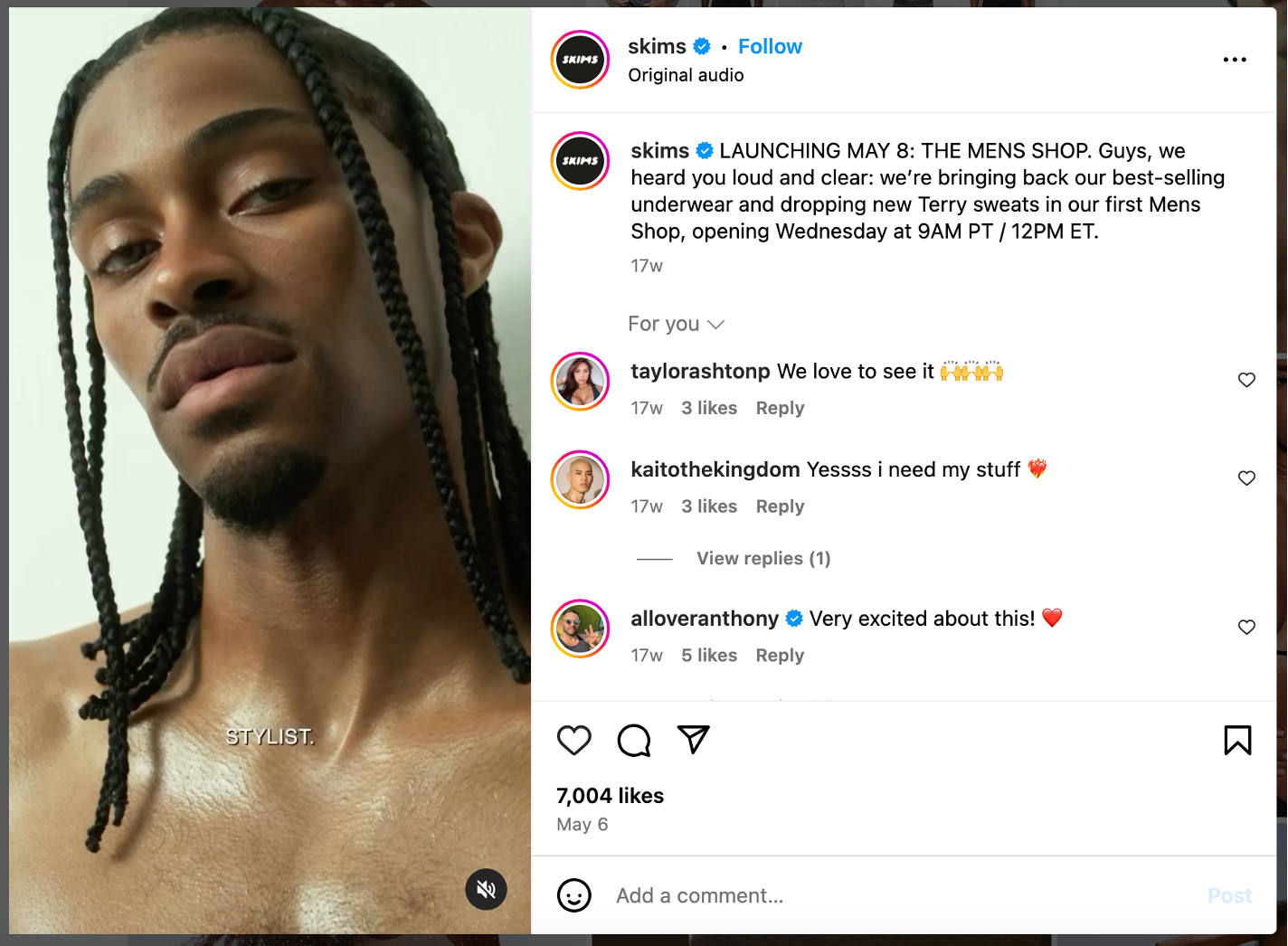
But Skims doesn’t stop at sharing—interaction is key.
The brand uses targeted hashtags like #skimshaul to encourage customers to share their purchases, turning buyers into brand advocates. And this user-generated content isn’t just free advertising, it’s a lesson in effective trust-building.
Real people showing how Skims products fit and feel? That’s social proof money can’t buy.
3. Taking advantage of FOMO
Scarcity marketing has always been a powerful tool, and Skims has perfected it.
The brand uses a “drop” model, releasing limited quantities of new products.

This creates a sense of urgency, prompting customers to act fast or risk missing out. It’s the classic fear of missing out (FOMO) at work, and it’s highly effective.
By keeping supply low and demand high, Skims maintains its products’ desirability. The perceived value of an item increases when it’s harder to get, and Skims has mastered the art of making its customers feel that when they get their hands on an in-demand product, they’re part of an exclusive club.
4. Targeting the right audience with Facebook ads
Facebook is a goldmine for brands that know how to use its ad tools, and Skims is no exception. By leveraging Facebook’s advanced targeting options, Skims ensures its ads hit the most relevant audience.
Here’s how they’re likely targeting their ads:
- Women aged 25-44: This age group dominates Facebook’s user base and aligns with Skims’ core customer profile.
- Fashion, beauty, and lifestyle enthusiasts: Skims goes after users who already show an interest in these categories, making their ads more likely to resonate.
- Past customers and website visitors: Skims likely retargets people who’ve already interacted with their content, reminding them about items they may have left in their cart.
To keep things fresh, Skims uses a variety of ad formats.
Image ads showcase their commitment to inclusivity:
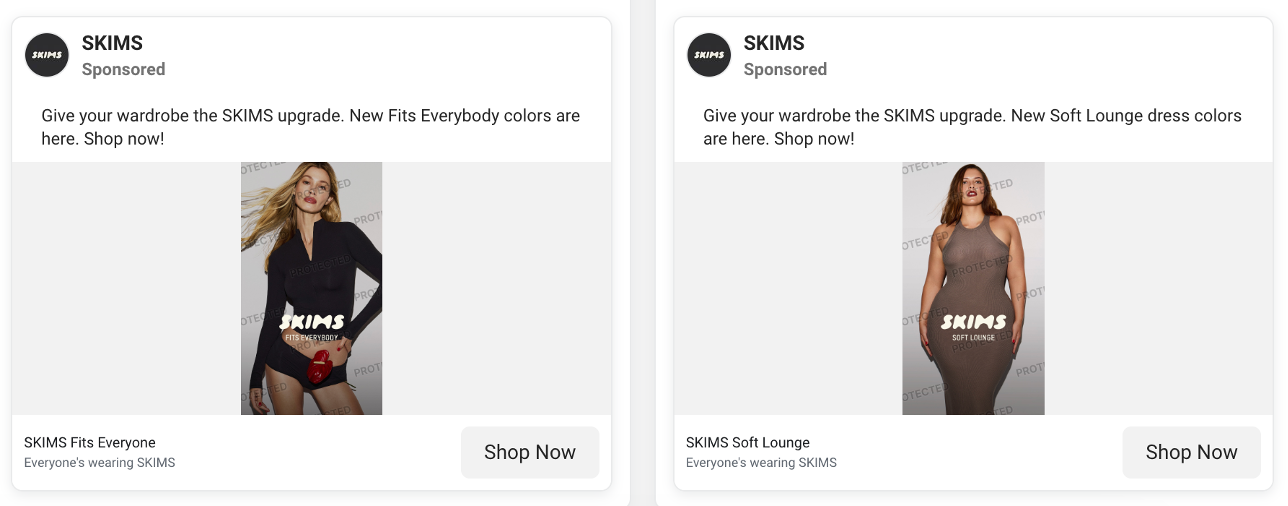
Video ads highlight product features:
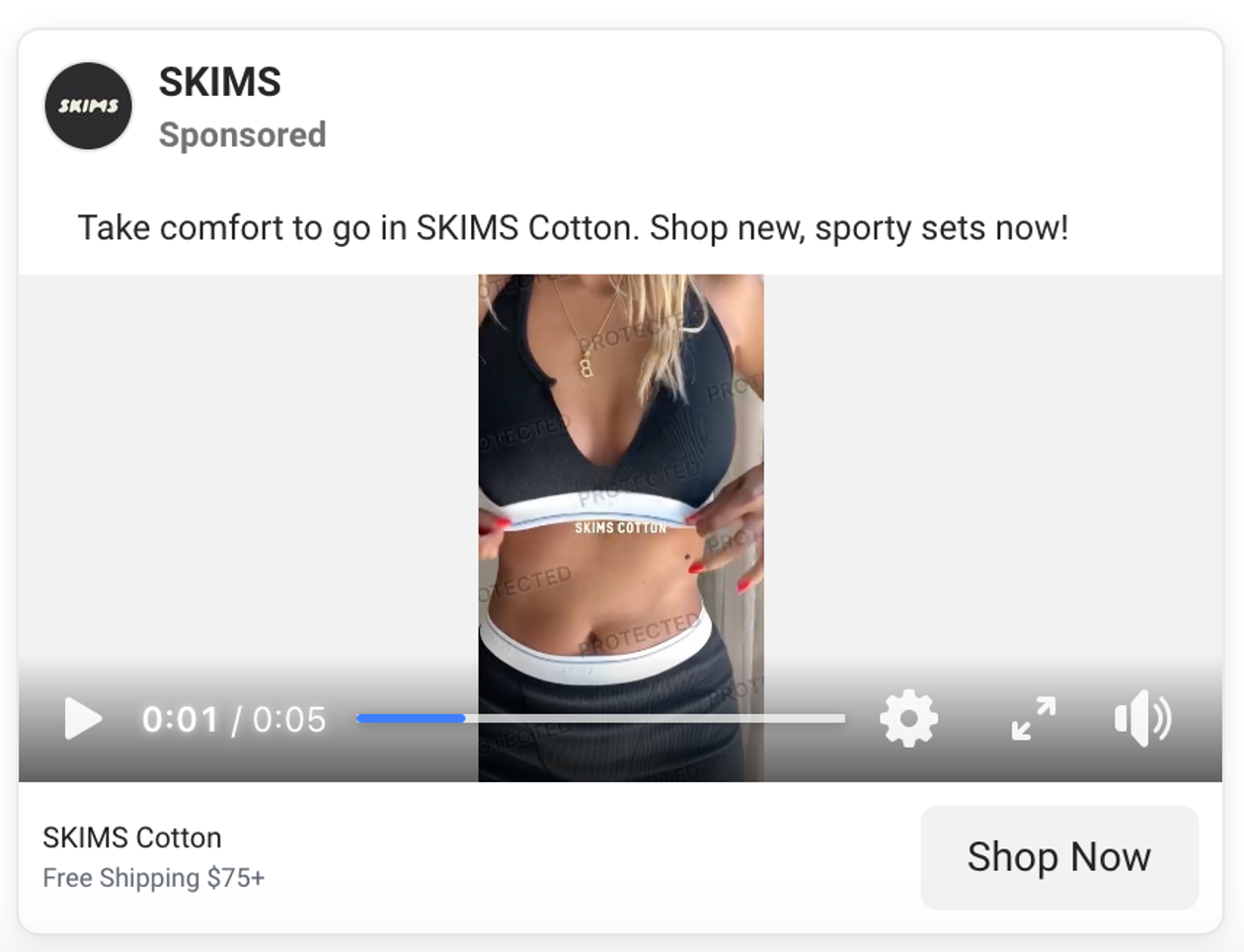
Ads featuring customer reviews build trust:

And when it comes to retargeting? Skims is on point.
By serving ads to users who have previously engaged with their website, they can nudge potential buyers towards completing their purchase.
5. Using popups to get more conversions
When you visit the Skims website, you’ll notice several smart popup tactics they’re using to enhance the user experience and drive conversions.
For example, a geotargeting popup asks you to select your country and currency, ensuring a smoother shopping experience.
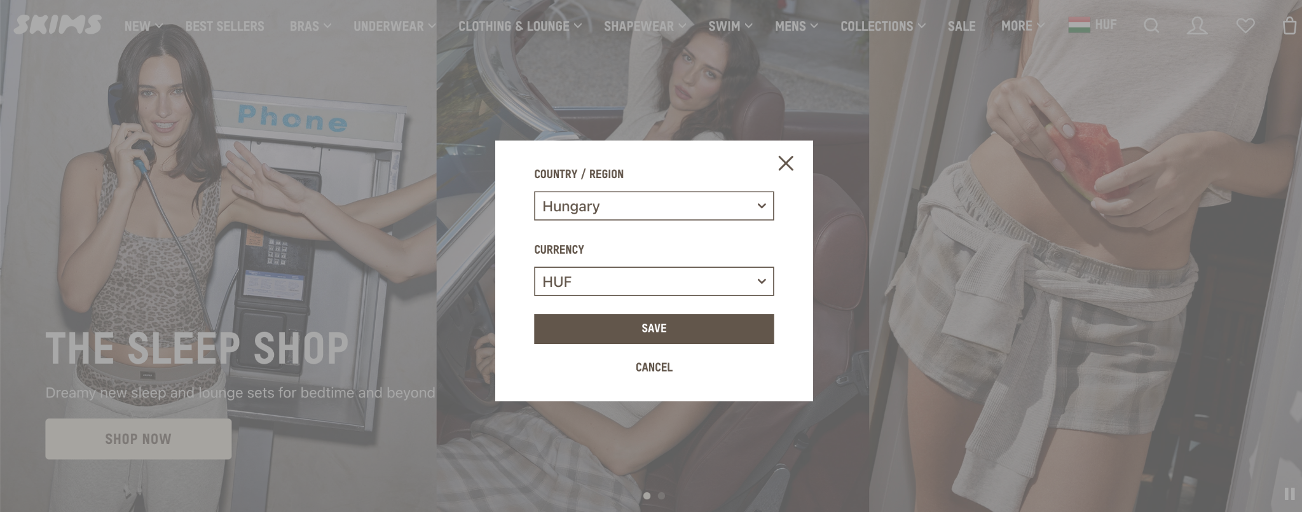
Then there’s the timed popup—after you’ve spent a little time browsing, a newsletter signup popup appears.
Interestingly, Skims doesn’t dangle the usual discount carrot. Instead, they position the value of joining the list as getting first dibs on new products and updates.
This approach creates a sense of exclusivity without devaluing the brand by overusing discounts.
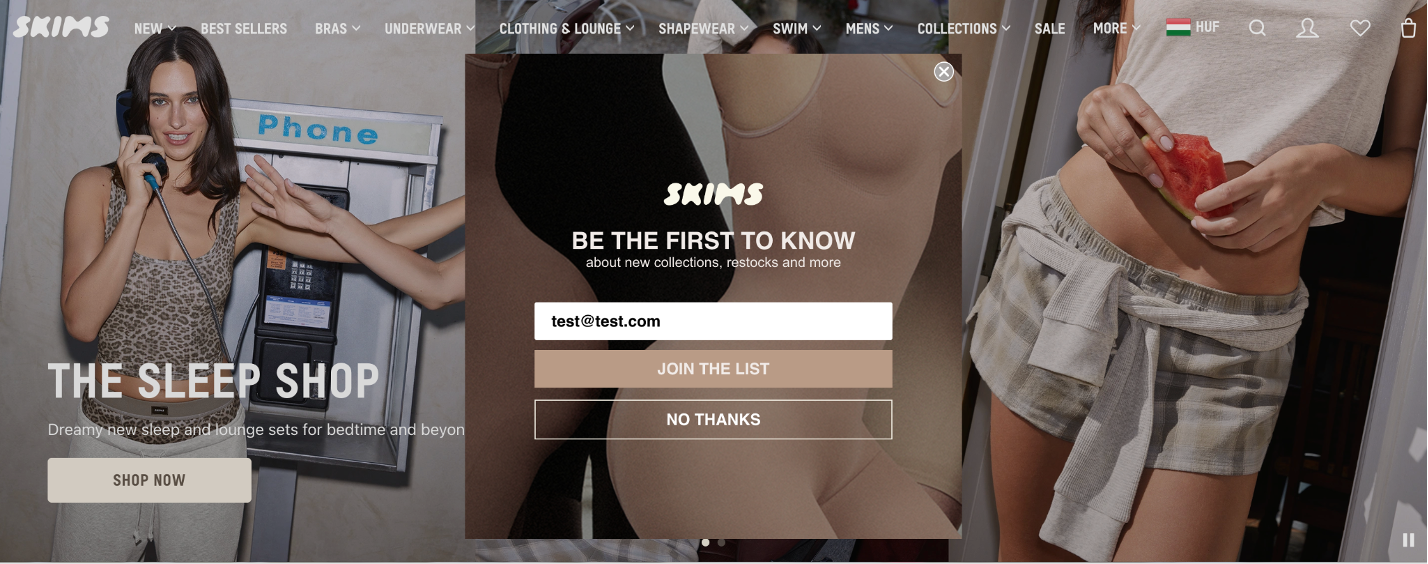
6. Staying top of mind with email marketing
Skims isn’t shy about keeping in touch with its customers. On average, they send five emails per week, keeping subscribers informed about new drops, restocks, and special events.

This email strategy does more than just drive sales—it fosters loyalty. Skims customers know they’re getting timely, relevant updates, and many eagerly await the next message from the brand.
Email is a direct line to the customer, and Skims uses it effectively to create a loyal base that stays highly engaged with the brand.
Wrapping up
Skims’ marketing success is no accident. From embracing diversity to mastering social media and employing scarcity tactics, Skims has created a brand that not only resonates with its audience but keeps them coming back for more.
In an industry often criticized for being exclusive, Skims has built an empire by doing the opposite.
By welcoming all, creating urgency, and staying connected, Skims isn’t just selling shapewear—they’re shaping the future of fashion marketing.
Learn more
Looking for more marketing breakdowns? Check out these articles:
- How Crocs Turned “Ugly” into Iconic: A Marketing Breakdown
- From Viral Stunts to Controversy: The Marketing Strategy Behind Prime Hydration
- Lululemon Marketing Breakdown: Secrets Behind the $9.61-Billion Success Story
- How Rare Beauty Became Gen Z’s Favorite Makeup Brand on TikTok
- Liquid Death Marketing Breakdown: How They Became a Billion-Dollar Brand
- How Waterdrop Revolutionized the Beverage Industry: A Marketing Deep Dive
Migration has never been easier
We made switching a no-brainer with our free, white-glove onboarding service so you can get started in the blink of an eye.

What should you do next?
Thanks for reading till the end. Here are 4 ways we can help you grow your business:
Boost conversions with proven use cases
Explore our Use Case Library, filled with actionable personalization examples and step-by-step guides to unlock your website's full potential. Check out Use Case Library
Create a free OptiMonk account
Create a free OptiMonk account and easily get started with popups and conversion rate optimization. Get OptiMonk free
Get advice from a CRO expert
Schedule a personalized discovery call with one of our experts to explore how OptiMonk can help you grow your business. Book a demo
Join our weekly newsletter
Real CRO insights & marketing tips. No fluff. Straight to your inbox. Subscribe now
Nikolett Lorincz
- Posted in
- Marketing Breakdowns
Partner with us
- © OptiMonk. All rights reserved!
- Terms of Use
- Privacy Policy
- Cookie Policy
Product updates: January Release 2025








